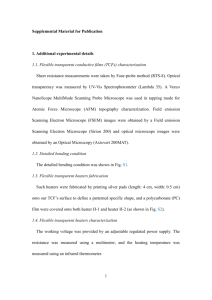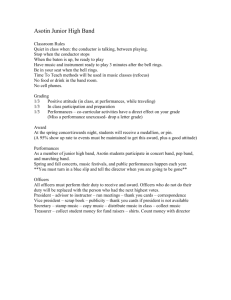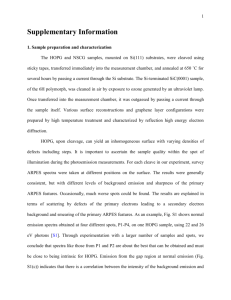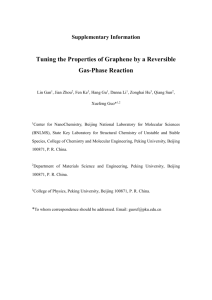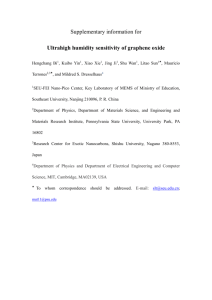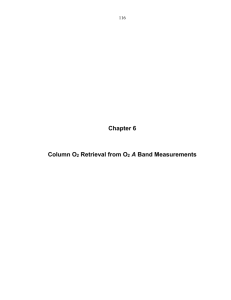Supporting Information - Springer Static Content Server
advertisement
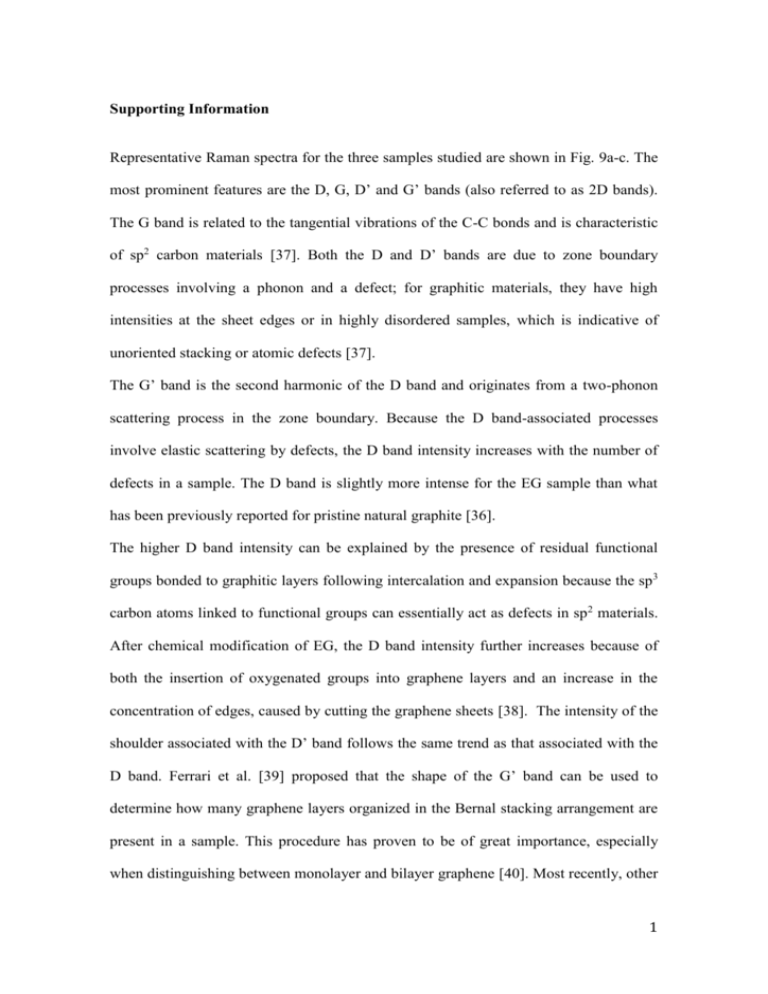
Supporting Information Representative Raman spectra for the three samples studied are shown in Fig. 9a-c. The most prominent features are the D, G, D’ and G’ bands (also referred to as 2D bands). The G band is related to the tangential vibrations of the C-C bonds and is characteristic of sp2 carbon materials [37]. Both the D and D’ bands are due to zone boundary processes involving a phonon and a defect; for graphitic materials, they have high intensities at the sheet edges or in highly disordered samples, which is indicative of unoriented stacking or atomic defects [37]. The G’ band is the second harmonic of the D band and originates from a two-phonon scattering process in the zone boundary. Because the D band-associated processes involve elastic scattering by defects, the D band intensity increases with the number of defects in a sample. The D band is slightly more intense for the EG sample than what has been previously reported for pristine natural graphite [36]. The higher D band intensity can be explained by the presence of residual functional groups bonded to graphitic layers following intercalation and expansion because the sp3 carbon atoms linked to functional groups can essentially act as defects in sp2 materials. After chemical modification of EG, the D band intensity further increases because of both the insertion of oxygenated groups into graphene layers and an increase in the concentration of edges, caused by cutting the graphene sheets [38]. The intensity of the shoulder associated with the D’ band follows the same trend as that associated with the D band. Ferrari et al. [39] proposed that the shape of the G’ band can be used to determine how many graphene layers organized in the Bernal stacking arrangement are present in a sample. This procedure has proven to be of great importance, especially when distinguishing between monolayer and bilayer graphene [40]. Most recently, other 1 methods also using the G’ band profile have been proposed for counting the number of layers present in few- and multi-layer graphene samples [41, 42]. The fit proposed by Graf et al. [41] is based on the evolution of the spectral separation between the two Lorentzians used to fit the G’ band (what is call the G’ band here is called the D’ band by Graf et al). This spectral separation ranges from 19 cm-1 for bilayer graphene to 44 cm-1 for bulk HOPG. Based on the fit proposed by Graf et al. [41], both the GO and the GO-TETA samples (Fig. 9b-c) are essentially composed of few-layer graphene, likely having ~4-6 layers. This statement is readily supported by the AFM and TEM micrographs, in which graphene flakes with different height profiles were observed within this range. Although this fitting method was proposed for mechanically exfoliated graphene samples (not functionalized), the good agreement between the number of layers obtained by both Raman spectroscopy and AFM is convincing. Fig. 9 (a) Raman spectra for the EG, GO and GO-TETA samples; G’ band fitting for (b) GO and (c) GO-TETA based on three measurements taken from the same sample. The numbers shown in (b) and (c) correspond to the separation between the two Lorentzian maxima. 2 Detailed XPS spectra of the C1s and O1s regions are shown in Fig. 10a-d. The C1s core-level spectra of all three samples show a dominant peak located at ~ 284.5 eV, which is associated with sp2 hybridized carbon bonds [47] in extensively π conjugated systems. A secondary peak observed at ~285.1 eV was attributed to the sp3 C-C bonds present at defect locations on the graphitic surface [48]. The peak at ~286.2 eV peak was attributed to –CO-R or free radical sp3 bonded –OH groups [32]. Other oxygenated groups were introduced to the surface of EG during the production of GO nanosheets; evidence of oxidation is confirmed by the peak at ~289.2 eV (Fig. 10b-c), which is typical of carboxylic carbons. An additional photoemission peak observed at 287.9 eV (Fig. 10c) is characteristic of the carbon atoms of carbonyl groups (-C=O). At ~290.3 eV, a satellite peak was observed (Fig. 10b-c), which is associated with the π-π* electronic transition [47]. An adjustment of the XPS O1s peaks provided additional information about the oxygen-containing groups on the surface. The curve fitting of the O1s peak for GOTETA, as shown in Fig. 10d, indicates the presence of four oxygen functionalities. The peak at ~532 eV is attributed to both the oxygen atoms of the carbonyl groups in esters, amides and anhydrides and the oxygen atoms of either hydroxyls or ethers. The peak at 533.5 eV is attributed to the ether oxygen atoms in carbonyl groups [49]. The peaks at 534.4 and 535.6 eV can be assigned to the O-H bond of water associated with oxygencontaining functional groups on the surface of graphene [50]. 3 Fig. 10 High resolution XPS spectra obtained in the C1s binding energy region for (a) EG, (b) GO, (c) GO-TETA, and the signal for O1s in (d) GO-TETA. The surface morphologies of the cryofractured samples of the epoxy resin nanocomposites and of the EG and GO-TETA nanocomposites are shown in Fig 10b-d. In general, the crosslinked epoxy resin presents a smooth appearance with solid lines of crack propagation. All nanocomposite samples that were produced exhibited strong interfacial adhesion between the graphene nanosheets and the host polymer. 4 Fig. 11 SEM micrographs (fractured samples) for neat resin (a) and epoxy composites with (b) 0.5 wt% of EG and (c and d) 1.0 and 3.0 wt% of GO-TETA. 5
